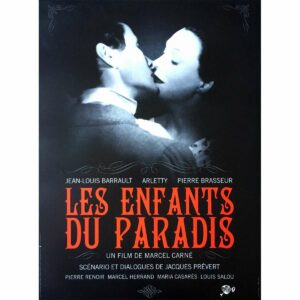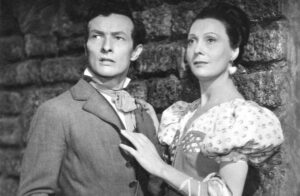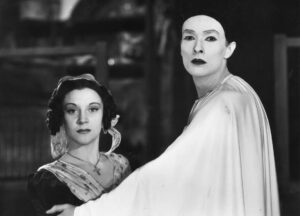“Children of Paradise” – a Loving Tribute to Acting

Title: “Children of Paradise”
Release Date: 1945
Director: Marcel Carné
Cast: Jean-Louis Barrault, Arletty, María Casares, Pierre Brasseur, Pierre Renoir, Marcel Herrand
“Children of Paradise” by Marcel Carné is a work that, on the centenary of the birth of cinema, the French considered the most perfect film in history. The picture premiered at the end of World War II was a tribute to the art of acting and theater, allowing the audience to cope with the changing currents of history and internal conflicts. Set in 19th-century realities, the love story set in a community of actors is quintessentially French. At the same time, the film reiterates the old but profound truth that we are all the title comedians, playing roles according to the script that fate writes, and sometimes we sit in the audience, watching the adventures of other characters.
“Children of Paradise” – a beautiful courtesan and her four admirers
Marcel Carné filmed “Children of Paradise” at the end of World War II, which was quite a difficult undertaking, especially due to the setting of the action in the first half of the 19th century. The events are set on the Boulevard des Crimes in Paris, where many theaters were located, including “Les Funambules” and the Grand Theater. In order to condense the main events, the film is divided into two parts: “Boulevard of Crime” and “The Man in White”. Already in the prologue the viewer gets acquainted with the outline of the story. Well, beautiful courtesan Garance (Arletty) is wrongly implicated in a criminal affair, but thanks to the help of a young mime in love with her, Baptiste Deburau (Jean-Louis Barrault), she manages to get out of it. However, when she gets into trouble again, she leaves town with a wealthy count to save herself. After seven years, Garance returns to Paris again and immediately electrifies male society.
During her absence, Baptiste manages to marry the theater director’s daughter Nathalie (Maria Casares), with whom he has a son, who is in love with him. The woman, knowing her husband’s past affection for Garance, tries to prevent them from meeting again, as do three admirers vying for the courtesan’s charms. They are the great comedic actor Frederick Lemaitre (Pierre Brasseur), the anarchist and murderer and, incidentally, author of not very successful plays Lacenaire (Marcel Herrand) and the beautiful lady’s current protector – Count Edouard de Montray (Louis Salou).

Despite the intricate intrigues of each of the characters in the drama, fate reunites the paths of the most brilliant Parisian mime and Garance. The man is ready to leave his wife for her, but when Nathalie finds them together in the bedroom, the courtesan, moved by the devotion of her rival, leaves. However, the woman has no idea that she can’t return to the wealthy aristocrat, as the latter has just been murdered by Lacenaire. Garance disappears into the amused carnival crowd, and Baptiste calls her name in vain and tries to find his beloved among the disguised people around him.
“Children of Paradise” – a theater of life and love
The movie “Children of Paradise” is based on the old Shakespearean theme of the theater mundi. Therefore, art mixes with life, and the roles played on stage with the most private roles. Marcel Carné has strongly emphasized here the changing position of the audience and the actors – who perform in front of the audience, but at other times sit in the audience to watch the performance. We are also dealing here with the motif of theater within theater – for the film begins and ends with the curtain, which makes the “real” adventures of the characters be taken in a kind of quotation marks and turn out to be another fabrication. “Children of Paradise” thus describes the human condition in terms of acting, and life as a constant performance played to the delight of the audience – fate, God or simply other people.
Of particular importance in this theatricalization of the world are the masks assumed, which hide the true face. Particularly telling here is the last scene, when Baptiste cannot find Garance among the carnivalesque disguises, and then he himself becomes just one of many mime-simulators. His character thus acquires the status of an everyman – a type signifying every – man, while his lover is a figure of every woman and her existential dilemmas. This treatment also underscores the inevitable conventionalization of love, in that, although we think our feeling is unique, we are essentially playing out the same performance over and over again, in which we are twinned with other comedians. We desire to reverse the course of the past and do a better job in our assigned roles, but there is no going back to the way things were, and all attempts to overcome fate are doomed to failure in advance.

“Children of Paradise” as a tribute to French art
The place of “Children of Paradise” on the map of French cinema is inextricably linked to the historical context. The film premiered at the end of World War II: March 9, 1945 at the Palais de Chaillot and received an enthusiastic reception. The picture was read as a tribute to the centuries-old tradition of French theater, acting and also cinema, and a harbinger of their great revival. Here we have an accumulation of typical national motifs: French theatrical styles, authentic characters of the era (the main character Baptiste is the famous mime Jean-Gaspard Deburau), themes familiar from the literature of Balzac or Diderot and the French art of conversation. We also have a portrait of the decline of the Bourbon era, which can be read as a parabola of the moral changes at the end of the war. “Children of Paradise” therefore represented the artistic inauguration of a new chapter in French history, and even years later exemplifies the ideal realization of poetic style.
Literature:
„Kino klasyczne”, pod red. T. Lubelskiego, I. Sowińskiej i R. Syski, Kraków 2012.
A.Garbicz, J. Klinowski, „Kino, wehikuł magiczny. Przewodnik osiągnięć filmu fabularnego. Podróż pierwsza 1913 – 1949, Kraków 2007.
